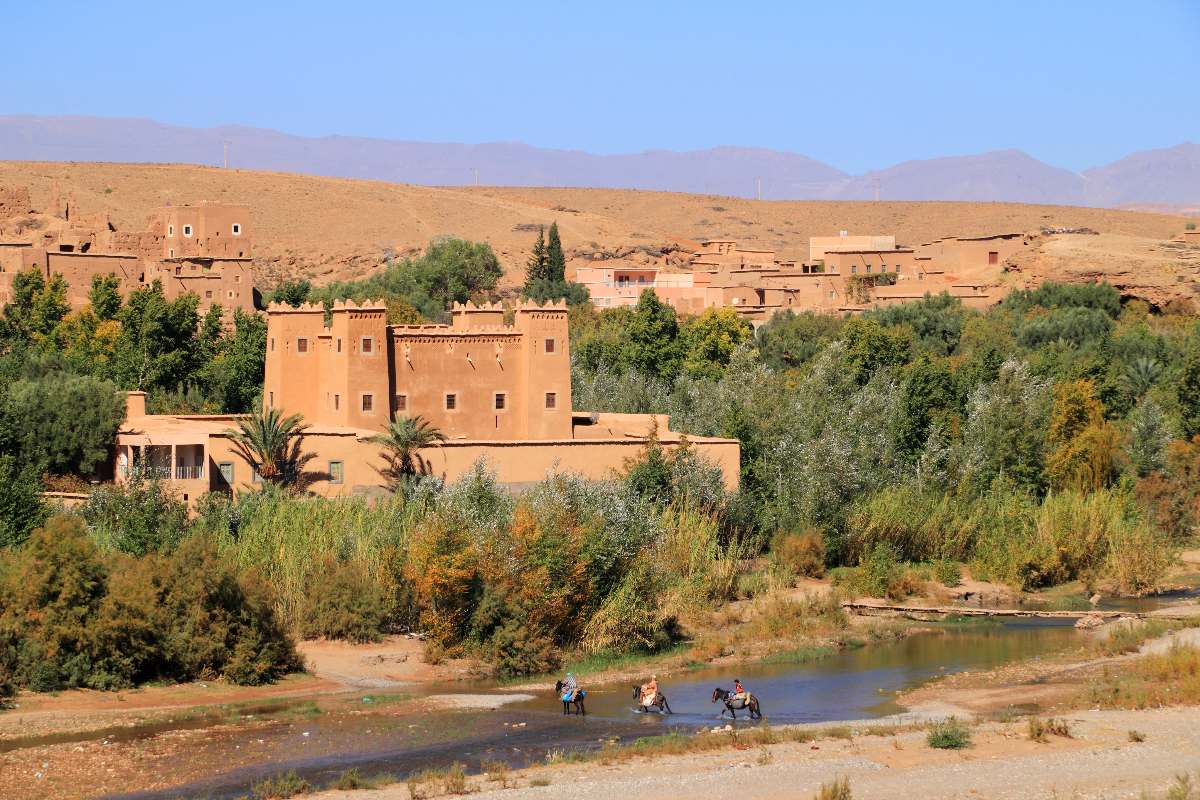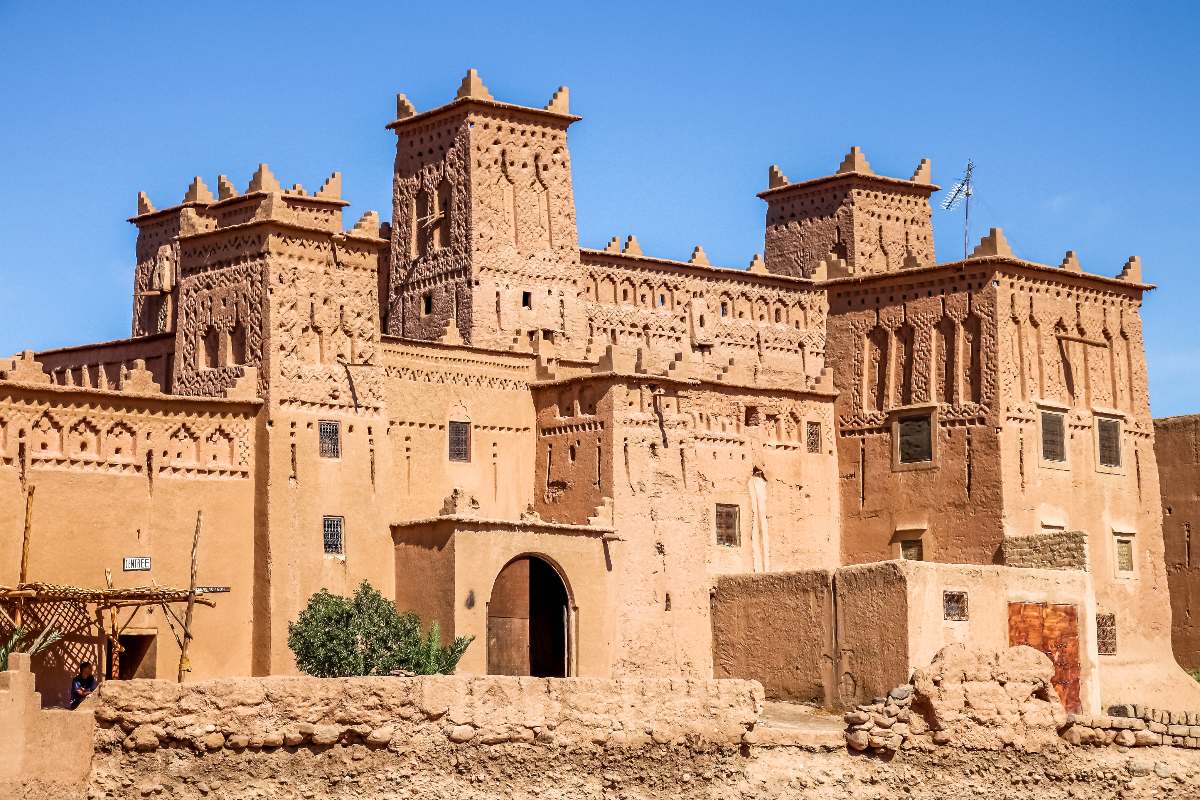Touring the Dades Valley is one of the preferred options for those traveling to the Sahara Desert (Merzouga) from Marrakech. Its natural beauty is composed of mountains and rocky gorges of warm colors, as well as oases that dot the terrain from time to time. In addition, there are historic buildings that survive in an imposing manner, as if by magic. As a whole, it is an area of Morocco that can be conceived as a whole, since its villages and natural corners share characteristics that you will be able to discover by road.
The Dades Valley is a large area south of the Atlas, in what is known as the pre-Saharan area, since it is the prelude to the Sahara desert itself. Its backbone is the Dades River, which rises in the High Atlas (high valley of Msemrir) and flows into another river, the Draa, near the city of Ouarzazate. However, it is a highly seasonal river, which means that many of its stretches lack water in the driest months.
What is known as the Dades Valley comprises an area of about 180 km from the area around Tinghir (secondary valley of the Todra) to Ouarzazate, in the Draa-Tafilalet region. The valley has a northeast-southwest configuration, and the N10 road runs through it.
It is an area with a very low population density, as is the case in the entire pre-Saharan area south of the Atlas. As a result, public transport communications are very scarce, if not nonexistent in many of its points.
The major gateway to the Dades Valley is Ouarzazate, which has an international airport nearby. But given the limited air traffic and the non-existence of railroad lines, the most common way to get here is by road from Marrakech, crossing the High Atlas through the port of Tizi n’Tichka.
These are the distances that separate Ouarzazate from other tourist destinations in the country:
And these are the distances that separate Tinghir, at the other end of the Dades Valley, from other tourist destinations in the country:
The climate of the Dades Valley is arid in terms of rainfall, due to its proximity to the Sahara Desert. But it is important to keep in mind a key factor in its temperatures: its altitude. Ouarzazate, for example, is at 1,150 meters above sea level, while Tinghir is at 1,350 meters above sea level. This means that the thermal oscillations are really pronounced between day and night, with hot afternoons in summer, but in winter temperatures can become freezing.
As for the landscape, the Dades Valley is dominated by rocky mountains on both sides, all of them bare and of a color that varies depending on the time of day: orange, pink, brown, yellow… The course of the Dades River, as well as that of some tributaries such as the Todra, sometimes runs very boxed, resulting in really narrow rocky cliffs and gorges, like gorges.
When the terrain flattens out and moves away from the river, a hammada landscape emerges, i.e., an arid and stony desert. And of course, also very characteristic are the oases that arise in different areas, where palm groves, fruit trees, orchards and plant species adapted to the climate are concentrated.

The Dades Valley is mainly made up of small villages that share a common history, almost always linked to the only economic activities that developed in the area centuries ago: agriculture, livestock and services associated with the nomads who traveled the caravan route that passed through here, linking Fez or Marrakech with Timbuktu, or the small Berber settlements with each other.
These routes were not free of dangers and, some time after the Arab conquest of the region, they were traveled by the armies of the ruling dynasties in present-day Morocco (Almoravids, Almohads, Marinids, Alaouites…).
Therefore, along the Dades Valley and in the neighboring valleys of Draa and Roses, there is a construction that literally jumps out on numerous occasions: the kasbah, that is, small fortresses that were built on top of a hill or mountain to monitor the route and were made of adobe, with crenellated towers and geometric decoration in different parts of the facade. That is why, for tourism, the Dades Valley is part of the so-called Route of the Thousand Kasbahs, which runs through the pre-Saharan area and also includes the Draa Valley.
Draa Valley
and of the Roses.
During the 20th century, this area fell under the French Protectorate. Then, the city of Ouarzazate was created as a base of operations for the French army, and today it is the largest in the area and also the most modern from an urbanistic point of view (although it is not lacking in historical buildings).
The Moroccan army also considers Ouarzazate a strategic military base for control and operations in such a vast region. But what has really been a plus for the movement of people and life in the Dades Valley has been the tourist exploitation of the area: thousands of tourists pass through here every year, either as the final destination of their trip or as a transit area to the Sahara desert. This has allowed the restoration of many kasbahs and historic buildings to be adapted as riads, restaurants, wellness spaces and other traveler-oriented services.
The Dades Valley is not as famous a tourist destination as the Imperial Cities.
Imperial Cities
o
the coasts of the Mediterranean or the Atlantic
. But it does have the power to attract travelers of different profiles: from the adventurous to the sporty, from the spiritual to the naturalist. If you need to load up on reasons to travel here, here are some that may be useful:
Given its almost linear layout (with some branching in the form of secondary valleys) of the Dades Valley, the route will allow you to stop at all these places of interest, which we list from west to east:

The Dades Valley, as you will discover on your trip, is inhabited by people with really humble lifestyles, who are largely engaged in agriculture and livestock, and frequent markets of street stalls in the open air, where services such as Internet or digital payments are not as widespread as in other parts of the country. However, these humble people have also been able to develop an extremely hospitable and high quality service for travelers who honor them with their visit. So, if you want to enjoy an experience of maximum comfort, the Dades Valley also has surprises to offer:
Ksar Ighnda: An authentic retreat located at the gateway to the desert, it offers a blend of tradition and modernity with luxurious amenities such as a heated pool, spa and a gourmet restaurant.
Le Berbère Palace: Located in Ouarzazate, it is one of the most luxurious hotels in the region. With traditional architecture and decoration, it offers modern amenities, extensive gardens, swimming pool and high quality restaurants.
Kasbah Tamsna: Offers a unique experience with its charming Berber decor and serene atmosphere amidst the natural landscape of the valley.
Kasbah Tamadot: Although it is not in the Dades Valley, it deserves to be mentioned because of its exclusivity and luxury. Owned by Sir Richard Branson, Kasbah Tamadot is located in the Berber village of Asni, in the Atlas Mountains near Marrakech. It is a true oasis of luxury with stunning gardens, panoramic views, opulent suites and luxurious Berber tents.
And if there is an agency that can bring together all these services and provide them with confidence, that is Chic Morocco: we have numerous suppliers in the Dades Valley, specialized in dealing with travelers demanding quality, and with facilities adapted to the new times so that you can feel at home during your trip. Contact us and let us help you set up a premium experience in this part of the country.








Fill out the form below to receive a free, no-obligation, tailor-made quote from an agency specialized in Morocco.
Travel agency and DMC specialized in private and tailor-made trips to Morocco.
Mandala Tours, S.L, NIF: B51037471
License: C.I.AN-187782-3